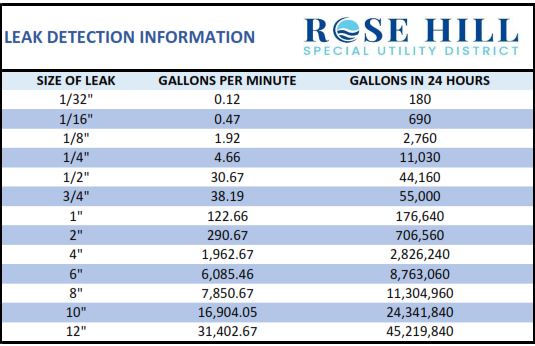Leak Detection Advice
Below is a chart to help you understand how much water can be lost from even the tiniest leak. Please help us conserve this precious resource – fix all leaking pipes, toilets and hoses or turn off water.
Please report any water main leaks to us immediately at 972-932-3077. Do not assume that someone else has called first!
Leak Detection Advice:
- Locate the water meter: Generally found towards the front of your property, near the road on either side of the property line. Once you have found the meter you can turn off the water to repair any leaks using your cut-off valve.
- Check the meter: Turn off all water inside and outside the home. For a brass meter with electronic register locate the silver spinner in the middle of the display, and/or the red dial. If either one is spinning, water is moving through the meter which is an indicator of a leak somewhere on the property or in the home. For a digital meter look at the left side of the display, there is a vertical bar that will have an arrow pointing towards the house. Check the box with the three digits located next to “GPM”. If there are any numbers other than zero showing, water is moving through the meter which is an indicator of a leak somewhere on the property or in the home.
- Check the service line running from the meter to the house: While this may sound difficult, you can save money if you can locate the leak for the plumber. If you know you have a shut-off valve by the house, shut it off temporarily and check the meter by removing the lid and watching the dial on top of the meter. If you can't see the meter head, try digging around because they sometimes have dirt or grass covering the top of them. Once you locate it and the valve is turned off by the house, watch the meter to see if it is turning. If it is still turning, then the leak is between the meter and the house. At this point, walk the area between the meter and the shut-off valve. Look for signs of a leak such as: soft muddy areas, grass that is greener than the rest or growing much faster than other areas. If you see such an obvious sign, call a plumber or make the repair yourself.
- Take a walk around the house: Does the grass in your yard have puddles or large wet spots? These may be indications of a water leak.
- Check any inside or outside faucets, irrigation system or pool: Look at hoses, taps, faucets and irrigation systems. A slow drip can waste as much as 170 gallons of water each day and will add to your water bill.
- Check all toilets for leaks: Remove the top off the tank and listen very closely. If you hear any hissing at all, try to locate where it is coming from. If you locate the area where the leak is coming from determine if you can fix it. If you cannot, then call a plumber. You can also add food coloring to the tank and if it leaks out into the bowl it usually will be an indication to change out the flapper. A leaky toilet can waste 200 gallons of water per day. It is estimated that nearly 20 percent of all toilets leak.
- Check showerheads for leaks: Do not assume the water droplets in your shower or tub are left over from your intended use.
- Follow the Money: Compare your water utilities bill with past bills to see if it is larger than usual. Also, check you bill for a leak alert from the meter.
- Hot Water Tanks: Check the Pressure Relief Valve on the hot water tank. Sometimes these valves are plumbed directly into a drain and may be leaking without your knowledge. If you cannot remove the drainpipe to check for a leak listen for a hissing sound, it may be leaking.


 Leak Detection Information
Leak Detection Information